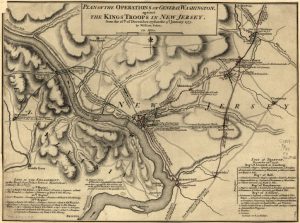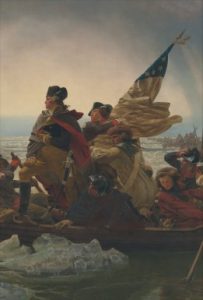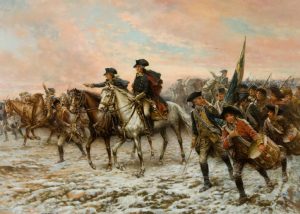henry knox
 The year was 1776, and it was Christmas Day, but for the men with George Washington, it was not a day of celebration…not exactly anyway. They were in the middle of fighting a war, and the fighting didn’t just stop because it was Christmas, not this year anyway. This was to be an unusual Christmas as far as wartime Christmases went. In 1776, it was difficult to fight a war in the wintertime, because the slower modes of travel. Most times in a war, the armies took the Winter off from warring, but this army was not laying up for the Winter. This war would continue on…no matter what the weather was like.
The year was 1776, and it was Christmas Day, but for the men with George Washington, it was not a day of celebration…not exactly anyway. They were in the middle of fighting a war, and the fighting didn’t just stop because it was Christmas, not this year anyway. This was to be an unusual Christmas as far as wartime Christmases went. In 1776, it was difficult to fight a war in the wintertime, because the slower modes of travel. Most times in a war, the armies took the Winter off from warring, but this army was not laying up for the Winter. This war would continue on…no matter what the weather was like.
Things looked bad that year. The Continental Army had suffered a series of defeats in their battle against the British oppression. After some successful maneuvers, Colonel Henry Knox came to the attention of General George Washington who worked to place him in overall command to the Continental Army. Under his command, the Continentals brought 18 cannon over the river…3  Pounders, 4 Pounders, some 6 Pounders, horses to pull the carriages, and enough ammunition for the coming battle. The 6 Pounders, weighing as much as 1,750 pounds were the most difficult to transport to the far side of the river. But in the end all the trouble of moving this large artillery train to Trenton proved its worth. Knox would place the bulk of his artillery at the top of the town where its fire commanded the center of Trenton.
Pounders, 4 Pounders, some 6 Pounders, horses to pull the carriages, and enough ammunition for the coming battle. The 6 Pounders, weighing as much as 1,750 pounds were the most difficult to transport to the far side of the river. But in the end all the trouble of moving this large artillery train to Trenton proved its worth. Knox would place the bulk of his artillery at the top of the town where its fire commanded the center of Trenton.
The plan devised by Knox and Washington was to conduct a surprise attack upon a Hessian garrison of roughly 1,400 soldiers located in and around Trenton, New Jersey. Washington hoped that a quick victory at Trenton would bolster sagging morale in his army and encourage more men to join the ranks of the Continentals in the coming new year. After several councils of war, General George Washington set the date for the river crossing for Christmas night 1776. It was an unprecedented plan, because the expectation was always that the armies would hold up somewhere for the winter. No one had attacked in winter before, and especially on Christmas. George Washington led 2,400 troops on a daring nighttime crossing of the icy Delaware River. Stealing into New Jersey, on December 26 the Continental forces launched the surprise attack on Trenton.
 The gamble paid off. Many of the Hessians were still disoriented from the previous night’s holiday bender, and colonial forces defeated them with minimal bloodshed. While Washington had pulled off a shock victory, his army was unequipped to hold the city and he was forced to re-cross the Delaware that same day…with nearly 1,000 Hessian prisoners in tow. Washington would go on to score successive victories at the Battles of the Assunpink Creek and Princeton, and his audacious crossing of the frozen Delaware served as a crucial rallying cry for the beleaguered Continental Army. The Revolutionary War would be won by the Continental Army of course, and the rules of warfare changed forever.
The gamble paid off. Many of the Hessians were still disoriented from the previous night’s holiday bender, and colonial forces defeated them with minimal bloodshed. While Washington had pulled off a shock victory, his army was unequipped to hold the city and he was forced to re-cross the Delaware that same day…with nearly 1,000 Hessian prisoners in tow. Washington would go on to score successive victories at the Battles of the Assunpink Creek and Princeton, and his audacious crossing of the frozen Delaware served as a crucial rallying cry for the beleaguered Continental Army. The Revolutionary War would be won by the Continental Army of course, and the rules of warfare changed forever.
 The Washington cousins, George and William, are cousins of my husband’s family as well, and so their heroism is of interest to me. General George Washington, before he became our first president, was a great general, who played a huge part in making the United States the great nation it is. But, there was another cousin, who played a part…whether George Washington knew that or not, I can’t say, but they did work together to bring a victory in the Revolutionary War that was quite unusual in it’s scope…for that era anyway. That cousin, was Henry Knox, who was born on July 25, 1750, the seventh of ten children of William and Mary Knox.
The Washington cousins, George and William, are cousins of my husband’s family as well, and so their heroism is of interest to me. General George Washington, before he became our first president, was a great general, who played a huge part in making the United States the great nation it is. But, there was another cousin, who played a part…whether George Washington knew that or not, I can’t say, but they did work together to bring a victory in the Revolutionary War that was quite unusual in it’s scope…for that era anyway. That cousin, was Henry Knox, who was born on July 25, 1750, the seventh of ten children of William and Mary Knox.
During the Revolutionary War, it was not unusual for armies to winter somewhere, and then pick up the war in the spring. Because they couldn’t go from place to place as quickly then as they do now, they were left with little choice. Soldiers could die in the frigid conditions, if they didn’t find someplace to wait out the winter months…or so it was thought. Knox was in the military serving with Massachusetts forces in the Army of Observation during the opening days of the Siege of Boston. His abilities soon brought him to the attention of new army commander General George Washington when the general inspected fortifications designed by Knox near Roxbury. The two men quickly became friends. When the army desperately needed artillery, Washington consulted Knox for advice in November 1775. Knox suggested the idea that the 59 cannons recently captured at the fall of forts Ticonderoga and Crown Point in upstate New York  could have a decisive impact on the outcome of the siege. Knox did not have a commission in the army, but John Adams in particular worked in the Second Continental Congress to acquire for him a commission as colonel of the army’s artillery regiment. Washington was so impressed that he put Knox in charge of an expedition to retrieve them even though Knox’s commission had not yet arrived. Reaching Ticonderoga on December 5, 1775, Knox commenced what came to be known as the noble train of artillery, hauling by ox-drawn sled 60 tons of cannons and other armaments across some 300 miles of ice covered rivers and snow draped Berkshire Mountains to the Boston siege camps.
could have a decisive impact on the outcome of the siege. Knox did not have a commission in the army, but John Adams in particular worked in the Second Continental Congress to acquire for him a commission as colonel of the army’s artillery regiment. Washington was so impressed that he put Knox in charge of an expedition to retrieve them even though Knox’s commission had not yet arrived. Reaching Ticonderoga on December 5, 1775, Knox commenced what came to be known as the noble train of artillery, hauling by ox-drawn sled 60 tons of cannons and other armaments across some 300 miles of ice covered rivers and snow draped Berkshire Mountains to the Boston siege camps.
The region they were traveling through to reach Boston was lightly populated and Knox had to overcome difficulties with hiring personnel and obtaining animals. On several occasions cannons crashed through the ice on river crossings, but the detail’s men were always able to recover them. In the end, what Knox had expected to take just two weeks actually took more than six, but he was finally able to report the arrival of the weapons train to Washington on January 27, 1776. The operation was called “one of the most stupendous feats of logistics” of the entire war by historian Victor Brooks. Knox’s effort is commemorated by a series of plaques marking the Henry Knox Trail in New York and Massachusetts.

Upon their arrival in Cambridge the cannons were immediately deployed to fortify the Dorchester Heights recently taken by Washington. So commanding was the new battery over Boston harbor the British withdrew their fleet to Halifax. With the siege ended, Knox undertook the improvement of defenses in Connecticut, Rhode Island, and New York City in anticipation of British attack there. In New York he met Alexander Hamilton, commander of the local artillery. The two men formed a close friendship that lasted until Hamilton’s death in 1804. During his military service Knox also established a close friendship with fellow Massachusetts native Benjamin Lincoln. Henry Knox would go down in history as being one of the great strategists in this nation.

